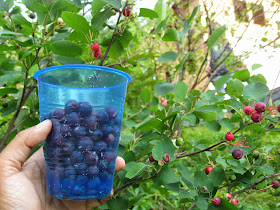 |
| A Sulphur and Buckeye butterflies nectar on a Stokes Aster. |
Although often considered great pollinators, both butterflies and moths really are not the best at moving pollen from one flower to the next. Unlike their pollinating colleagues, the bees, they just are not built to be good pollinators (and since many moths do not even feed as adults, many don't pollinate flowers at all). They lack enough "hair" to effectively carry pollen. Their long legs and proboscis often keep them from making much contact with pollen anyways and they thus don't carry much to other plants.
 |
| While not the best pollinators, this Eastern Tiger Swallowtail has certainly picked up pollen to transfer by burying itself in this daylily. |
But they do pollinate some plants. About 8% of the world's plants rely on Lepidoptera (butterflies and moths) as their primary pollinators. The pollination of plants by butterflies and moths is referred to as psychophily. Some butterflies and moths do also have the advantage of flying longer distances than other pollinators such as bees and transferring pollen longer distances with them. Some long-tongued moths (such as sphinx moths) are especially adept at pollination of night blooming flowers, and some plants have evolved to attract them as their primary pollinators. This was famously theorized by Darwin in 1862 when he predicted that an extremely long Madagascar orchid must have a pollinator with a proboscis 11 inches long in order to reach the nectaries, and he was right. Moth pollinated flowers are often tubular, white (what other color would show up at night?), and fragrant.
Butterfly pollinated plants are usually white, yellow or blue. They tend to have flat topped, open blooms to provide a good landing platform and easier access. Composite flowers provide multiple feeding opportunities per visit and are often favored as well. There tend to be less butterfly specific plants than moth specific plants.
Some plants hedge their bets attracting pollinators both day and night. Others appear to be more fragrant at night to attract nocturnal pollinators. A visit to a blooming buttonbush or common milkweed patch at night can reveal all sorts of visitors as proof.
 |
| Multiple Banded Tussock Moths feast on the Common Milkweed patch at my house. |
But there are also daytime flying moths, some of which are colorful. And of course there are many butterflies (Virginia has about 168 and Maryland has about 151 different species) who also visit flowers. Much like other pollinators, they are capable of learning which flowers to visit and which give them the best rewards. This benefits the butterfly/moth because it doesn't waste time finding flowers with less rewards unless it has to, and because it doesn't have to figure out how to access the nectar every time. It benefits the flowers of course because the pollen from the same species of flower ends up in another of the same species. Less is wasted than if the pollinator visited flowers randomly. Thus pollinators have evolved to benefit themselves and the plants they choose to visit.
 |
| The Ailanthus Webworm Moth, a daytime flying moth, favors goldenrods to nectar at. |
You can also make your yards and gardens more attractive to them (and to other pollinators) by doing just a few simple things, some butterfly/pollinator gardening basics:
•Avoid using pesticides and/or herbicides.
•Plant for continuous blooms throughout
the seasons.
•Use mass plantings.
•Include host plants.
•Provide basking sites.
•Consider puddling areas.
•Try to locate your garden in the sunniest
location you have.
•Consider flower color and shape.
•Avoid double-flowered or other cultivars.
•Go Native! Use the native plants they evolved with, not just to feed the adults, but even more so the caterpillars which often are very specific about the host plant they will feed on. So enjoy these colorful visitors to your gardens and yards. They may not be the best pollinators in the world, but they play their part. Even more so, their caterpillars form the largest proportion of food for our migratory birds, while the adult moths form the main dish for our bats. You might even recognize the same ones who visit from such things as damaged wings, knowing they learned that your yard had the best rewards. They then reward the plants in your yard, as well as the people who watch them.
 |
| This Great Spangled Fritillary got to know me pretty well in my yard. licking salt off my hand. |











.JPG)

